BUS703 Managing Research: Coaching, Role-Efficacy, & Trust Analysis
VerifiedAdded on 2023/06/11
|11
|2490
|491
Essay
AI Summary
This essay provides an evaluation of a research article focusing on leadership coaching, leader role-efficacy, and trust in subordinates. It assesses the literature review, highlighting the importance of leadership coaching in developing effectiveness, enhancing self-efficacy, and building trust. The essay discusses the characteristics and appropriateness of the mixed-methods research design used, justifying the use of focus groups and questionnaires for data collection. It also examines the sampling strategy and respondent selection, noting the use of probability sampling techniques. The analysis concludes that the research methods are adequately justified and effective for addressing the research objectives, providing valuable insights into the impact of leadership coaching on leadership development.

Running Head: Managing Research 1
Managing Research
Managing Research
Paraphrase This Document
Need a fresh take? Get an instant paraphrase of this document with our AI Paraphraser
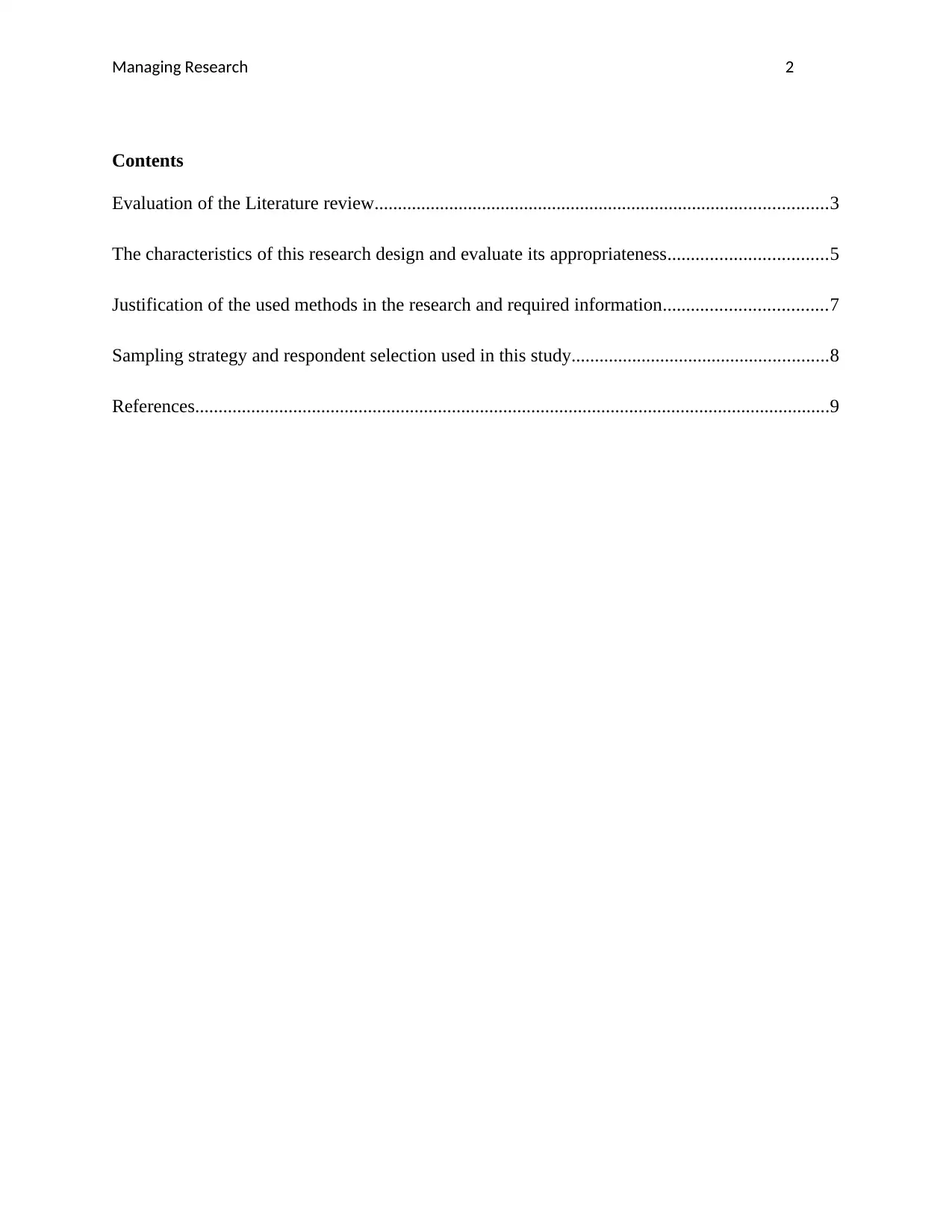
Managing Research 2
Contents
Evaluation of the Literature review.................................................................................................3
The characteristics of this research design and evaluate its appropriateness..................................5
Justification of the used methods in the research and required information...................................7
Sampling strategy and respondent selection used in this study.......................................................8
References........................................................................................................................................9
Contents
Evaluation of the Literature review.................................................................................................3
The characteristics of this research design and evaluate its appropriateness..................................5
Justification of the used methods in the research and required information...................................7
Sampling strategy and respondent selection used in this study.......................................................8
References........................................................................................................................................9
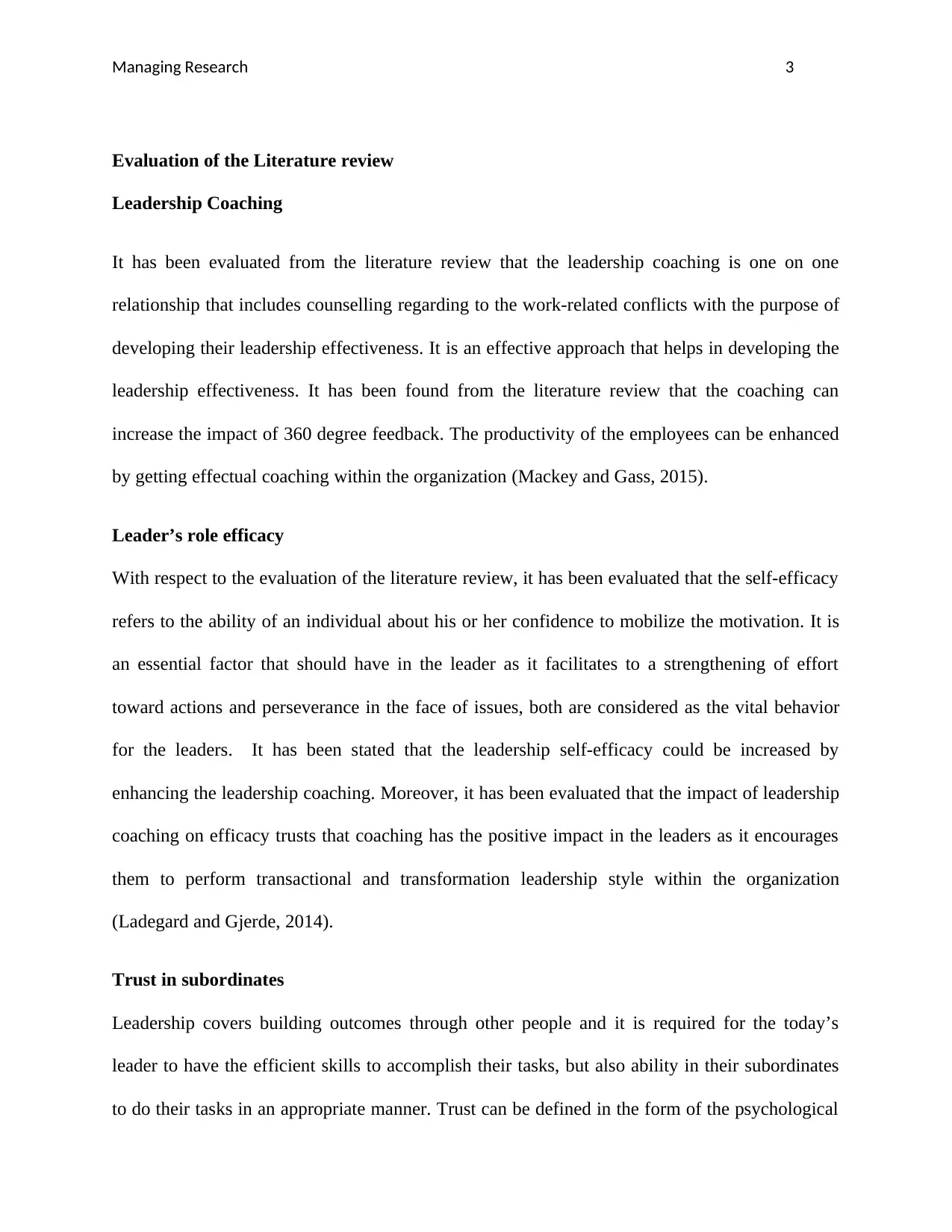
Managing Research 3
Evaluation of the Literature review
Leadership Coaching
It has been evaluated from the literature review that the leadership coaching is one on one
relationship that includes counselling regarding to the work-related conflicts with the purpose of
developing their leadership effectiveness. It is an effective approach that helps in developing the
leadership effectiveness. It has been found from the literature review that the coaching can
increase the impact of 360 degree feedback. The productivity of the employees can be enhanced
by getting effectual coaching within the organization (Mackey and Gass, 2015).
Leader’s role efficacy
With respect to the evaluation of the literature review, it has been evaluated that the self-efficacy
refers to the ability of an individual about his or her confidence to mobilize the motivation. It is
an essential factor that should have in the leader as it facilitates to a strengthening of effort
toward actions and perseverance in the face of issues, both are considered as the vital behavior
for the leaders. It has been stated that the leadership self-efficacy could be increased by
enhancing the leadership coaching. Moreover, it has been evaluated that the impact of leadership
coaching on efficacy trusts that coaching has the positive impact in the leaders as it encourages
them to perform transactional and transformation leadership style within the organization
(Ladegard and Gjerde, 2014).
Trust in subordinates
Leadership covers building outcomes through other people and it is required for the today’s
leader to have the efficient skills to accomplish their tasks, but also ability in their subordinates
to do their tasks in an appropriate manner. Trust can be defined in the form of the psychological
Evaluation of the Literature review
Leadership Coaching
It has been evaluated from the literature review that the leadership coaching is one on one
relationship that includes counselling regarding to the work-related conflicts with the purpose of
developing their leadership effectiveness. It is an effective approach that helps in developing the
leadership effectiveness. It has been found from the literature review that the coaching can
increase the impact of 360 degree feedback. The productivity of the employees can be enhanced
by getting effectual coaching within the organization (Mackey and Gass, 2015).
Leader’s role efficacy
With respect to the evaluation of the literature review, it has been evaluated that the self-efficacy
refers to the ability of an individual about his or her confidence to mobilize the motivation. It is
an essential factor that should have in the leader as it facilitates to a strengthening of effort
toward actions and perseverance in the face of issues, both are considered as the vital behavior
for the leaders. It has been stated that the leadership self-efficacy could be increased by
enhancing the leadership coaching. Moreover, it has been evaluated that the impact of leadership
coaching on efficacy trusts that coaching has the positive impact in the leaders as it encourages
them to perform transactional and transformation leadership style within the organization
(Ladegard and Gjerde, 2014).
Trust in subordinates
Leadership covers building outcomes through other people and it is required for the today’s
leader to have the efficient skills to accomplish their tasks, but also ability in their subordinates
to do their tasks in an appropriate manner. Trust can be defined in the form of the psychological
⊘ This is a preview!⊘
Do you want full access?
Subscribe today to unlock all pages.

Trusted by 1+ million students worldwide
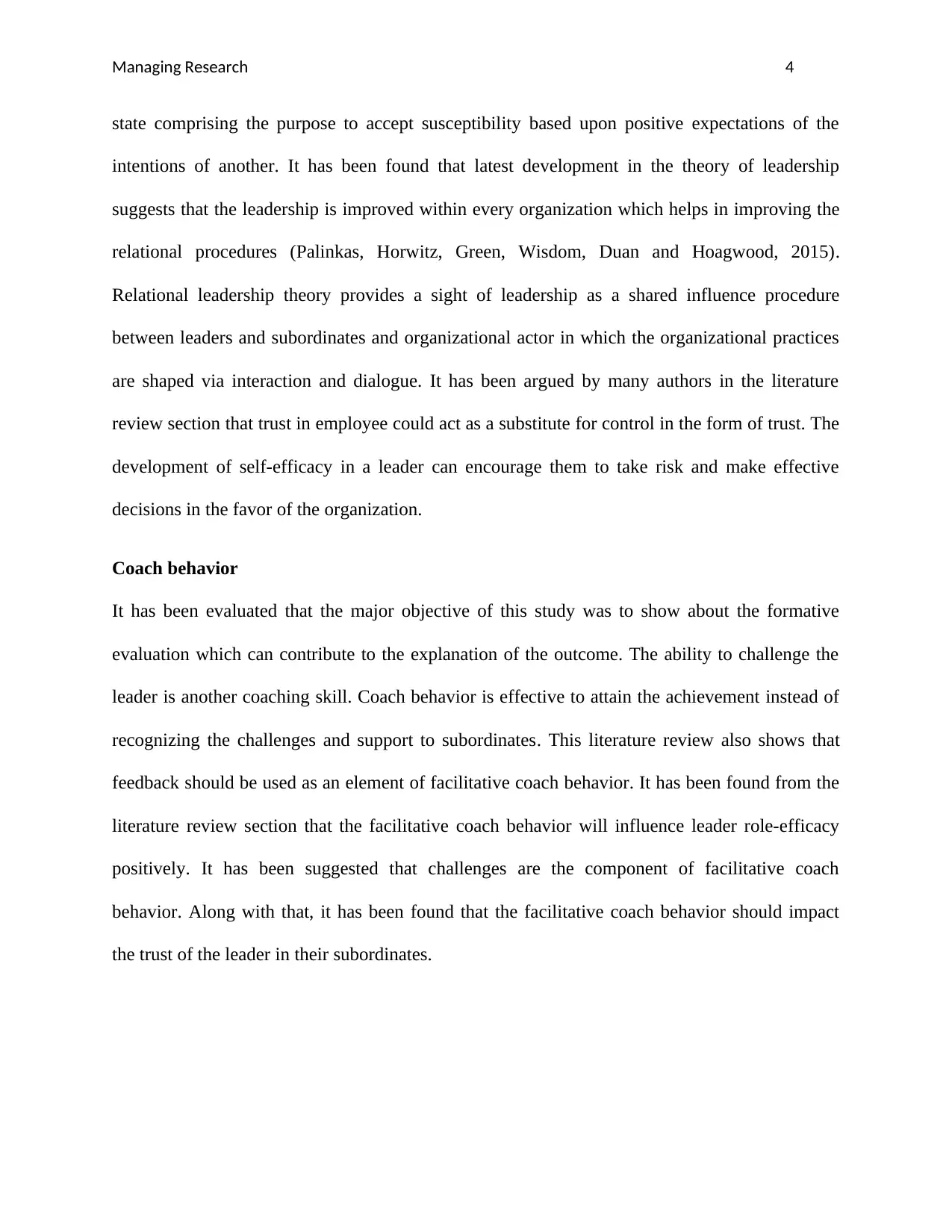
Managing Research 4
state comprising the purpose to accept susceptibility based upon positive expectations of the
intentions of another. It has been found that latest development in the theory of leadership
suggests that the leadership is improved within every organization which helps in improving the
relational procedures (Palinkas, Horwitz, Green, Wisdom, Duan and Hoagwood, 2015).
Relational leadership theory provides a sight of leadership as a shared influence procedure
between leaders and subordinates and organizational actor in which the organizational practices
are shaped via interaction and dialogue. It has been argued by many authors in the literature
review section that trust in employee could act as a substitute for control in the form of trust. The
development of self-efficacy in a leader can encourage them to take risk and make effective
decisions in the favor of the organization.
Coach behavior
It has been evaluated that the major objective of this study was to show about the formative
evaluation which can contribute to the explanation of the outcome. The ability to challenge the
leader is another coaching skill. Coach behavior is effective to attain the achievement instead of
recognizing the challenges and support to subordinates. This literature review also shows that
feedback should be used as an element of facilitative coach behavior. It has been found from the
literature review section that the facilitative coach behavior will influence leader role-efficacy
positively. It has been suggested that challenges are the component of facilitative coach
behavior. Along with that, it has been found that the facilitative coach behavior should impact
the trust of the leader in their subordinates.
state comprising the purpose to accept susceptibility based upon positive expectations of the
intentions of another. It has been found that latest development in the theory of leadership
suggests that the leadership is improved within every organization which helps in improving the
relational procedures (Palinkas, Horwitz, Green, Wisdom, Duan and Hoagwood, 2015).
Relational leadership theory provides a sight of leadership as a shared influence procedure
between leaders and subordinates and organizational actor in which the organizational practices
are shaped via interaction and dialogue. It has been argued by many authors in the literature
review section that trust in employee could act as a substitute for control in the form of trust. The
development of self-efficacy in a leader can encourage them to take risk and make effective
decisions in the favor of the organization.
Coach behavior
It has been evaluated that the major objective of this study was to show about the formative
evaluation which can contribute to the explanation of the outcome. The ability to challenge the
leader is another coaching skill. Coach behavior is effective to attain the achievement instead of
recognizing the challenges and support to subordinates. This literature review also shows that
feedback should be used as an element of facilitative coach behavior. It has been found from the
literature review section that the facilitative coach behavior will influence leader role-efficacy
positively. It has been suggested that challenges are the component of facilitative coach
behavior. Along with that, it has been found that the facilitative coach behavior should impact
the trust of the leader in their subordinates.
Paraphrase This Document
Need a fresh take? Get an instant paraphrase of this document with our AI Paraphraser
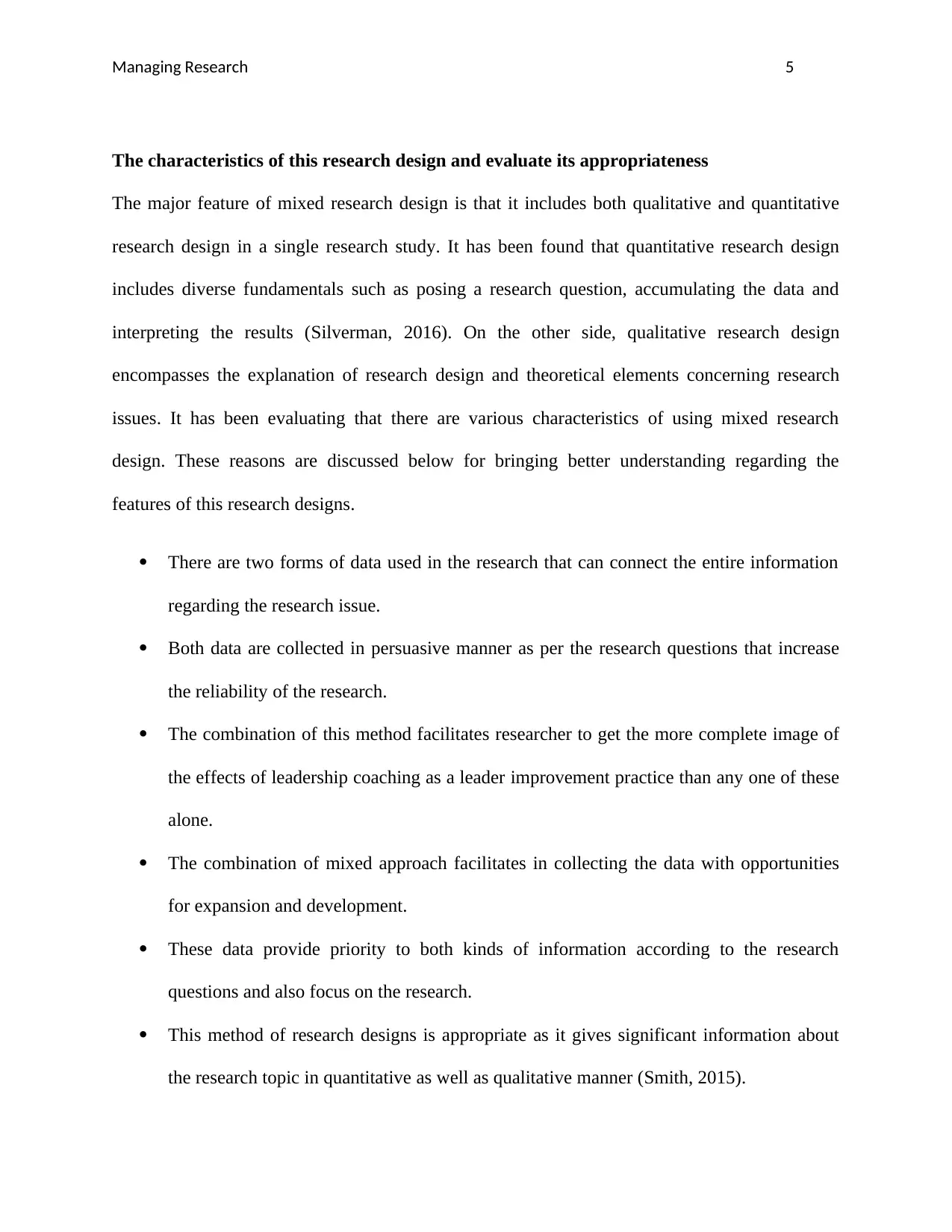
Managing Research 5
The characteristics of this research design and evaluate its appropriateness
The major feature of mixed research design is that it includes both qualitative and quantitative
research design in a single research study. It has been found that quantitative research design
includes diverse fundamentals such as posing a research question, accumulating the data and
interpreting the results (Silverman, 2016). On the other side, qualitative research design
encompasses the explanation of research design and theoretical elements concerning research
issues. It has been evaluating that there are various characteristics of using mixed research
design. These reasons are discussed below for bringing better understanding regarding the
features of this research designs.
There are two forms of data used in the research that can connect the entire information
regarding the research issue.
Both data are collected in persuasive manner as per the research questions that increase
the reliability of the research.
The combination of this method facilitates researcher to get the more complete image of
the effects of leadership coaching as a leader improvement practice than any one of these
alone.
The combination of mixed approach facilitates in collecting the data with opportunities
for expansion and development.
These data provide priority to both kinds of information according to the research
questions and also focus on the research.
This method of research designs is appropriate as it gives significant information about
the research topic in quantitative as well as qualitative manner (Smith, 2015).
The characteristics of this research design and evaluate its appropriateness
The major feature of mixed research design is that it includes both qualitative and quantitative
research design in a single research study. It has been found that quantitative research design
includes diverse fundamentals such as posing a research question, accumulating the data and
interpreting the results (Silverman, 2016). On the other side, qualitative research design
encompasses the explanation of research design and theoretical elements concerning research
issues. It has been evaluating that there are various characteristics of using mixed research
design. These reasons are discussed below for bringing better understanding regarding the
features of this research designs.
There are two forms of data used in the research that can connect the entire information
regarding the research issue.
Both data are collected in persuasive manner as per the research questions that increase
the reliability of the research.
The combination of this method facilitates researcher to get the more complete image of
the effects of leadership coaching as a leader improvement practice than any one of these
alone.
The combination of mixed approach facilitates in collecting the data with opportunities
for expansion and development.
These data provide priority to both kinds of information according to the research
questions and also focus on the research.
This method of research designs is appropriate as it gives significant information about
the research topic in quantitative as well as qualitative manner (Smith, 2015).
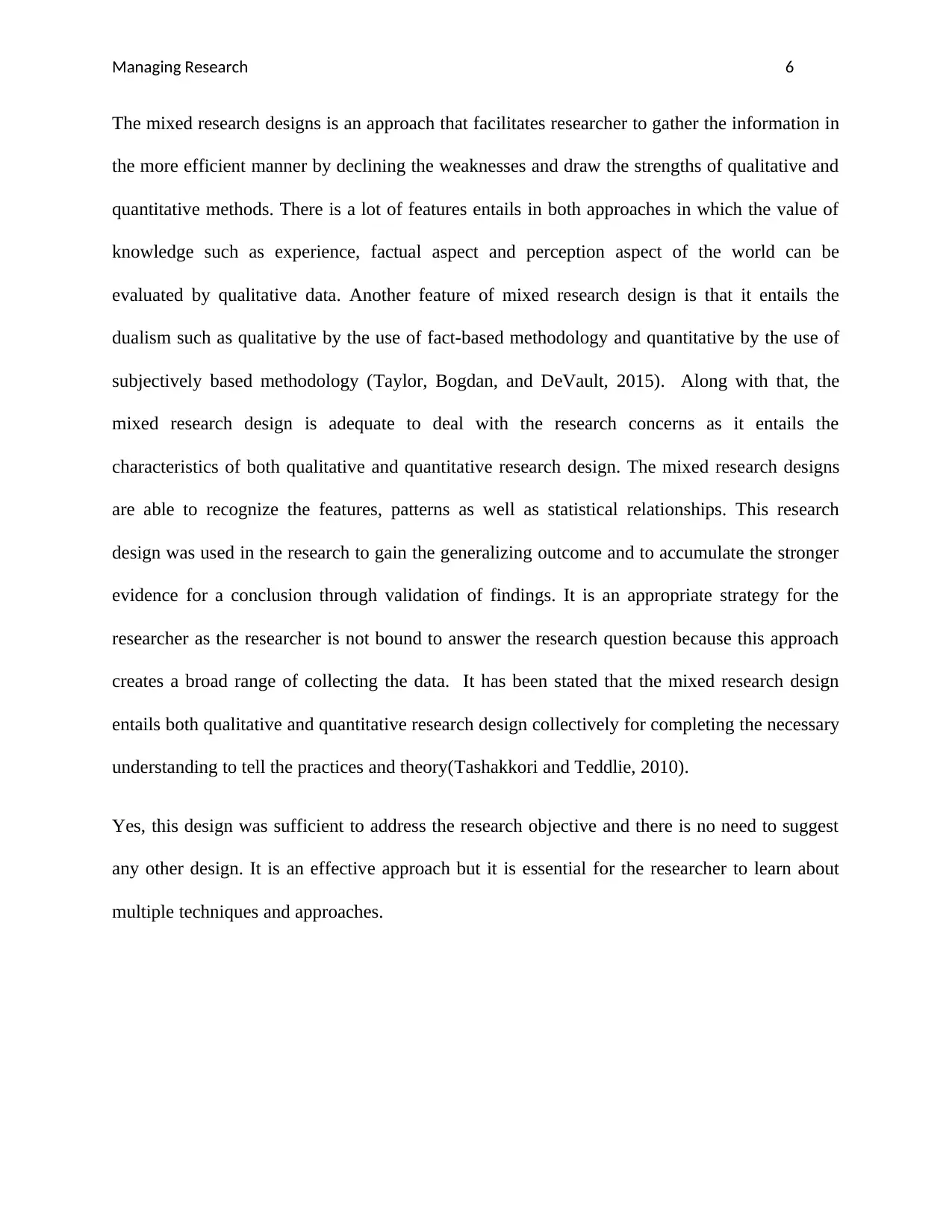
Managing Research 6
The mixed research designs is an approach that facilitates researcher to gather the information in
the more efficient manner by declining the weaknesses and draw the strengths of qualitative and
quantitative methods. There is a lot of features entails in both approaches in which the value of
knowledge such as experience, factual aspect and perception aspect of the world can be
evaluated by qualitative data. Another feature of mixed research design is that it entails the
dualism such as qualitative by the use of fact-based methodology and quantitative by the use of
subjectively based methodology (Taylor, Bogdan, and DeVault, 2015). Along with that, the
mixed research design is adequate to deal with the research concerns as it entails the
characteristics of both qualitative and quantitative research design. The mixed research designs
are able to recognize the features, patterns as well as statistical relationships. This research
design was used in the research to gain the generalizing outcome and to accumulate the stronger
evidence for a conclusion through validation of findings. It is an appropriate strategy for the
researcher as the researcher is not bound to answer the research question because this approach
creates a broad range of collecting the data. It has been stated that the mixed research design
entails both qualitative and quantitative research design collectively for completing the necessary
understanding to tell the practices and theory(Tashakkori and Teddlie, 2010).
Yes, this design was sufficient to address the research objective and there is no need to suggest
any other design. It is an effective approach but it is essential for the researcher to learn about
multiple techniques and approaches.
The mixed research designs is an approach that facilitates researcher to gather the information in
the more efficient manner by declining the weaknesses and draw the strengths of qualitative and
quantitative methods. There is a lot of features entails in both approaches in which the value of
knowledge such as experience, factual aspect and perception aspect of the world can be
evaluated by qualitative data. Another feature of mixed research design is that it entails the
dualism such as qualitative by the use of fact-based methodology and quantitative by the use of
subjectively based methodology (Taylor, Bogdan, and DeVault, 2015). Along with that, the
mixed research design is adequate to deal with the research concerns as it entails the
characteristics of both qualitative and quantitative research design. The mixed research designs
are able to recognize the features, patterns as well as statistical relationships. This research
design was used in the research to gain the generalizing outcome and to accumulate the stronger
evidence for a conclusion through validation of findings. It is an appropriate strategy for the
researcher as the researcher is not bound to answer the research question because this approach
creates a broad range of collecting the data. It has been stated that the mixed research design
entails both qualitative and quantitative research design collectively for completing the necessary
understanding to tell the practices and theory(Tashakkori and Teddlie, 2010).
Yes, this design was sufficient to address the research objective and there is no need to suggest
any other design. It is an effective approach but it is essential for the researcher to learn about
multiple techniques and approaches.
⊘ This is a preview!⊘
Do you want full access?
Subscribe today to unlock all pages.

Trusted by 1+ million students worldwide
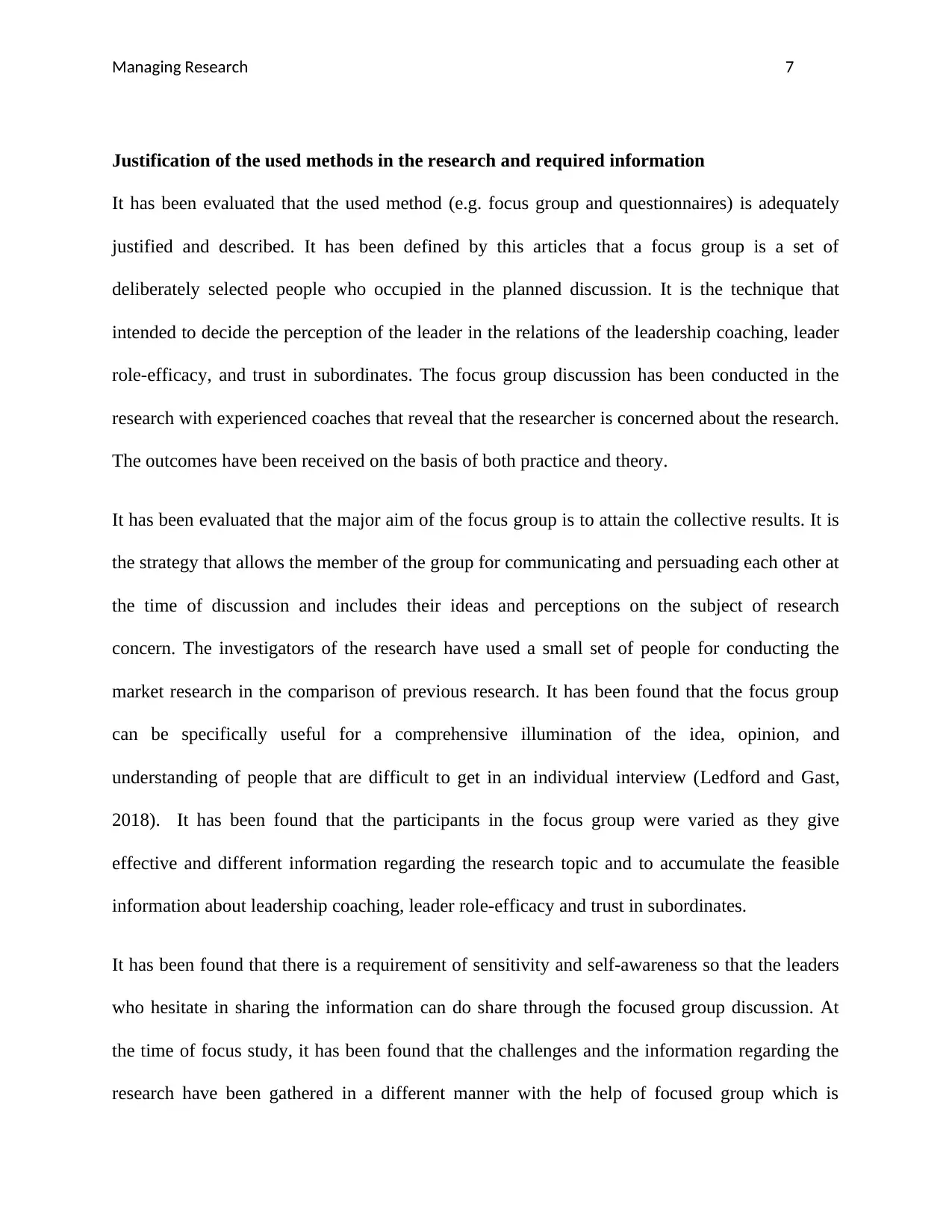
Managing Research 7
Justification of the used methods in the research and required information
It has been evaluated that the used method (e.g. focus group and questionnaires) is adequately
justified and described. It has been defined by this articles that a focus group is a set of
deliberately selected people who occupied in the planned discussion. It is the technique that
intended to decide the perception of the leader in the relations of the leadership coaching, leader
role-efficacy, and trust in subordinates. The focus group discussion has been conducted in the
research with experienced coaches that reveal that the researcher is concerned about the research.
The outcomes have been received on the basis of both practice and theory.
It has been evaluated that the major aim of the focus group is to attain the collective results. It is
the strategy that allows the member of the group for communicating and persuading each other at
the time of discussion and includes their ideas and perceptions on the subject of research
concern. The investigators of the research have used a small set of people for conducting the
market research in the comparison of previous research. It has been found that the focus group
can be specifically useful for a comprehensive illumination of the idea, opinion, and
understanding of people that are difficult to get in an individual interview (Ledford and Gast,
2018). It has been found that the participants in the focus group were varied as they give
effective and different information regarding the research topic and to accumulate the feasible
information about leadership coaching, leader role-efficacy and trust in subordinates.
It has been found that there is a requirement of sensitivity and self-awareness so that the leaders
who hesitate in sharing the information can do share through the focused group discussion. At
the time of focus study, it has been found that the challenges and the information regarding the
research have been gathered in a different manner with the help of focused group which is
Justification of the used methods in the research and required information
It has been evaluated that the used method (e.g. focus group and questionnaires) is adequately
justified and described. It has been defined by this articles that a focus group is a set of
deliberately selected people who occupied in the planned discussion. It is the technique that
intended to decide the perception of the leader in the relations of the leadership coaching, leader
role-efficacy, and trust in subordinates. The focus group discussion has been conducted in the
research with experienced coaches that reveal that the researcher is concerned about the research.
The outcomes have been received on the basis of both practice and theory.
It has been evaluated that the major aim of the focus group is to attain the collective results. It is
the strategy that allows the member of the group for communicating and persuading each other at
the time of discussion and includes their ideas and perceptions on the subject of research
concern. The investigators of the research have used a small set of people for conducting the
market research in the comparison of previous research. It has been found that the focus group
can be specifically useful for a comprehensive illumination of the idea, opinion, and
understanding of people that are difficult to get in an individual interview (Ledford and Gast,
2018). It has been found that the participants in the focus group were varied as they give
effective and different information regarding the research topic and to accumulate the feasible
information about leadership coaching, leader role-efficacy and trust in subordinates.
It has been found that there is a requirement of sensitivity and self-awareness so that the leaders
who hesitate in sharing the information can do share through the focused group discussion. At
the time of focus study, it has been found that the challenges and the information regarding the
research have been gathered in a different manner with the help of focused group which is
Paraphrase This Document
Need a fresh take? Get an instant paraphrase of this document with our AI Paraphraser
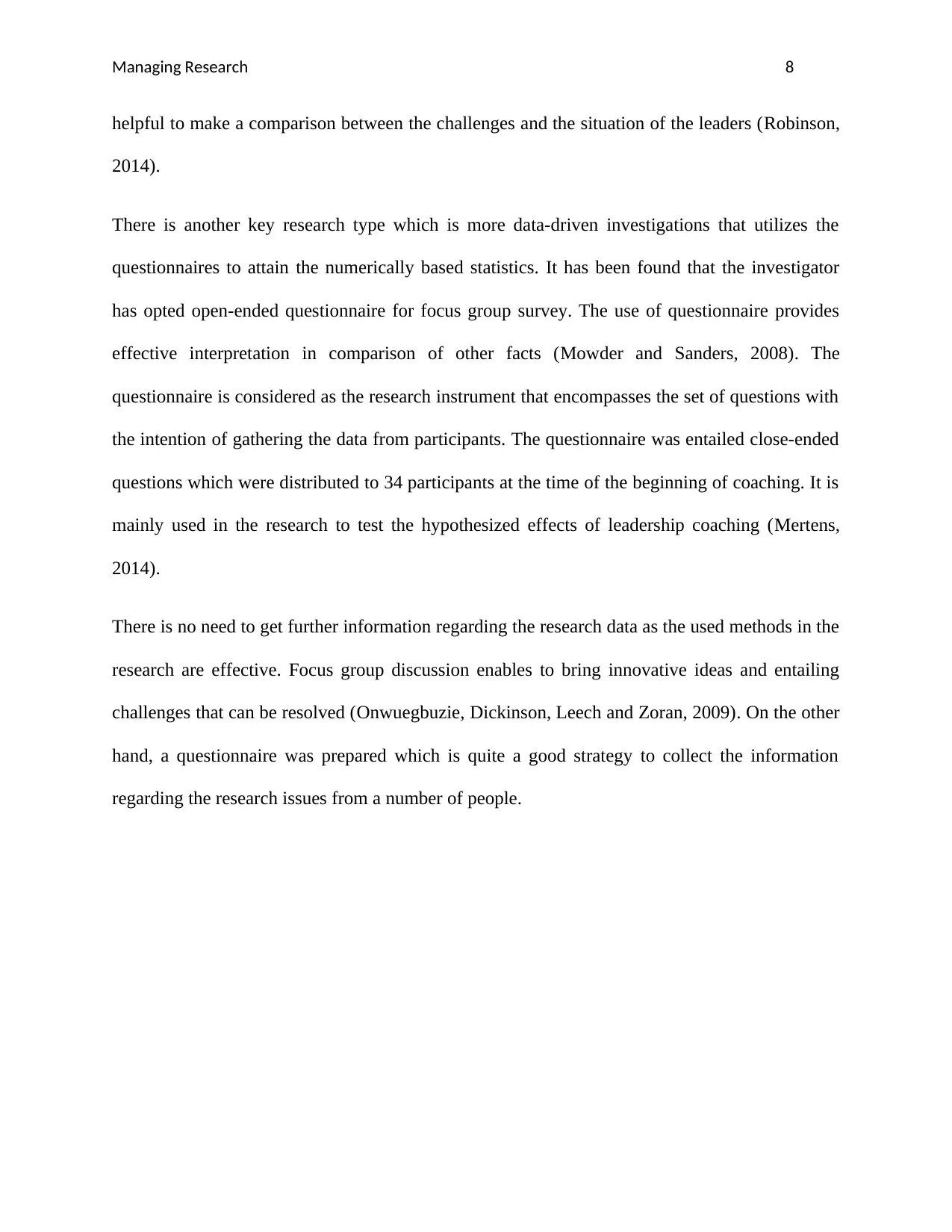
Managing Research 8
helpful to make a comparison between the challenges and the situation of the leaders (Robinson,
2014).
There is another key research type which is more data-driven investigations that utilizes the
questionnaires to attain the numerically based statistics. It has been found that the investigator
has opted open-ended questionnaire for focus group survey. The use of questionnaire provides
effective interpretation in comparison of other facts (Mowder and Sanders, 2008). The
questionnaire is considered as the research instrument that encompasses the set of questions with
the intention of gathering the data from participants. The questionnaire was entailed close-ended
questions which were distributed to 34 participants at the time of the beginning of coaching. It is
mainly used in the research to test the hypothesized effects of leadership coaching (Mertens,
2014).
There is no need to get further information regarding the research data as the used methods in the
research are effective. Focus group discussion enables to bring innovative ideas and entailing
challenges that can be resolved (Onwuegbuzie, Dickinson, Leech and Zoran, 2009). On the other
hand, a questionnaire was prepared which is quite a good strategy to collect the information
regarding the research issues from a number of people.
helpful to make a comparison between the challenges and the situation of the leaders (Robinson,
2014).
There is another key research type which is more data-driven investigations that utilizes the
questionnaires to attain the numerically based statistics. It has been found that the investigator
has opted open-ended questionnaire for focus group survey. The use of questionnaire provides
effective interpretation in comparison of other facts (Mowder and Sanders, 2008). The
questionnaire is considered as the research instrument that encompasses the set of questions with
the intention of gathering the data from participants. The questionnaire was entailed close-ended
questions which were distributed to 34 participants at the time of the beginning of coaching. It is
mainly used in the research to test the hypothesized effects of leadership coaching (Mertens,
2014).
There is no need to get further information regarding the research data as the used methods in the
research are effective. Focus group discussion enables to bring innovative ideas and entailing
challenges that can be resolved (Onwuegbuzie, Dickinson, Leech and Zoran, 2009). On the other
hand, a questionnaire was prepared which is quite a good strategy to collect the information
regarding the research issues from a number of people.
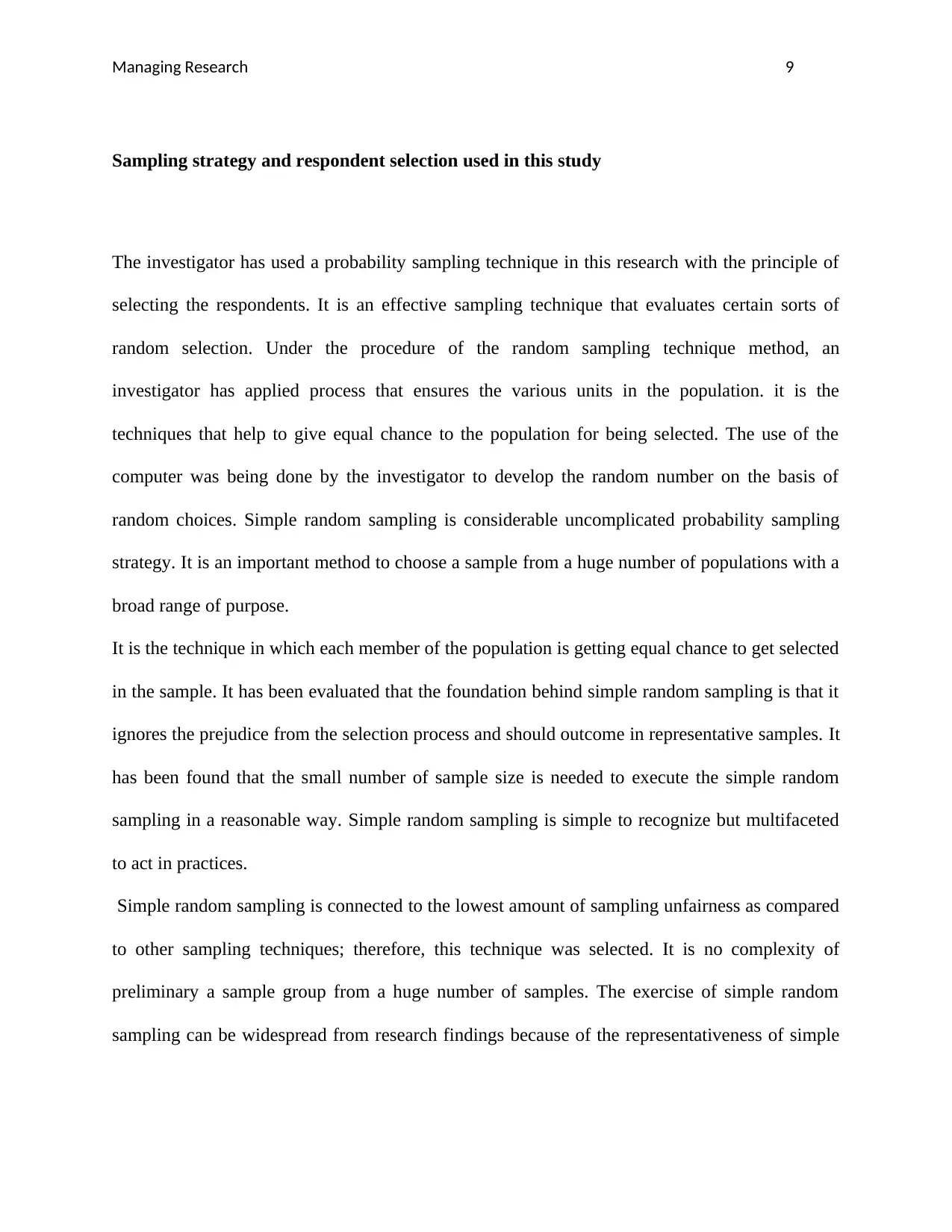
Managing Research 9
Sampling strategy and respondent selection used in this study
The investigator has used a probability sampling technique in this research with the principle of
selecting the respondents. It is an effective sampling technique that evaluates certain sorts of
random selection. Under the procedure of the random sampling technique method, an
investigator has applied process that ensures the various units in the population. it is the
techniques that help to give equal chance to the population for being selected. The use of the
computer was being done by the investigator to develop the random number on the basis of
random choices. Simple random sampling is considerable uncomplicated probability sampling
strategy. It is an important method to choose a sample from a huge number of populations with a
broad range of purpose.
It is the technique in which each member of the population is getting equal chance to get selected
in the sample. It has been evaluated that the foundation behind simple random sampling is that it
ignores the prejudice from the selection process and should outcome in representative samples. It
has been found that the small number of sample size is needed to execute the simple random
sampling in a reasonable way. Simple random sampling is simple to recognize but multifaceted
to act in practices.
Simple random sampling is connected to the lowest amount of sampling unfairness as compared
to other sampling techniques; therefore, this technique was selected. It is no complexity of
preliminary a sample group from a huge number of samples. The exercise of simple random
sampling can be widespread from research findings because of the representativeness of simple
Sampling strategy and respondent selection used in this study
The investigator has used a probability sampling technique in this research with the principle of
selecting the respondents. It is an effective sampling technique that evaluates certain sorts of
random selection. Under the procedure of the random sampling technique method, an
investigator has applied process that ensures the various units in the population. it is the
techniques that help to give equal chance to the population for being selected. The use of the
computer was being done by the investigator to develop the random number on the basis of
random choices. Simple random sampling is considerable uncomplicated probability sampling
strategy. It is an important method to choose a sample from a huge number of populations with a
broad range of purpose.
It is the technique in which each member of the population is getting equal chance to get selected
in the sample. It has been evaluated that the foundation behind simple random sampling is that it
ignores the prejudice from the selection process and should outcome in representative samples. It
has been found that the small number of sample size is needed to execute the simple random
sampling in a reasonable way. Simple random sampling is simple to recognize but multifaceted
to act in practices.
Simple random sampling is connected to the lowest amount of sampling unfairness as compared
to other sampling techniques; therefore, this technique was selected. It is no complexity of
preliminary a sample group from a huge number of samples. The exercise of simple random
sampling can be widespread from research findings because of the representativeness of simple
⊘ This is a preview!⊘
Do you want full access?
Subscribe today to unlock all pages.

Trusted by 1+ million students worldwide
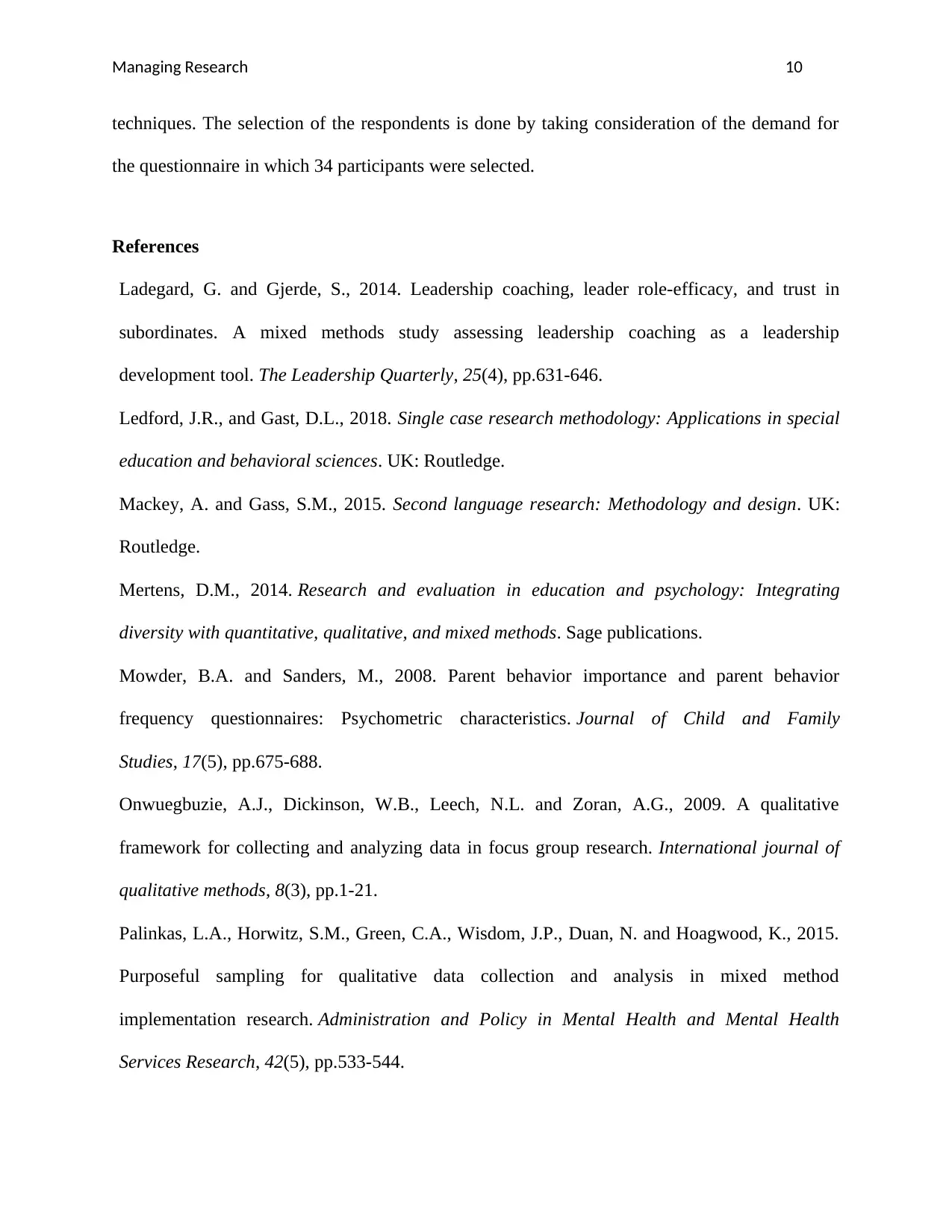
Managing Research 10
techniques. The selection of the respondents is done by taking consideration of the demand for
the questionnaire in which 34 participants were selected.
References
Ladegard, G. and Gjerde, S., 2014. Leadership coaching, leader role-efficacy, and trust in
subordinates. A mixed methods study assessing leadership coaching as a leadership
development tool. The Leadership Quarterly, 25(4), pp.631-646.
Ledford, J.R., and Gast, D.L., 2018. Single case research methodology: Applications in special
education and behavioral sciences. UK: Routledge.
Mackey, A. and Gass, S.M., 2015. Second language research: Methodology and design. UK:
Routledge.
Mertens, D.M., 2014. Research and evaluation in education and psychology: Integrating
diversity with quantitative, qualitative, and mixed methods. Sage publications.
Mowder, B.A. and Sanders, M., 2008. Parent behavior importance and parent behavior
frequency questionnaires: Psychometric characteristics. Journal of Child and Family
Studies, 17(5), pp.675-688.
Onwuegbuzie, A.J., Dickinson, W.B., Leech, N.L. and Zoran, A.G., 2009. A qualitative
framework for collecting and analyzing data in focus group research. International journal of
qualitative methods, 8(3), pp.1-21.
Palinkas, L.A., Horwitz, S.M., Green, C.A., Wisdom, J.P., Duan, N. and Hoagwood, K., 2015.
Purposeful sampling for qualitative data collection and analysis in mixed method
implementation research. Administration and Policy in Mental Health and Mental Health
Services Research, 42(5), pp.533-544.
techniques. The selection of the respondents is done by taking consideration of the demand for
the questionnaire in which 34 participants were selected.
References
Ladegard, G. and Gjerde, S., 2014. Leadership coaching, leader role-efficacy, and trust in
subordinates. A mixed methods study assessing leadership coaching as a leadership
development tool. The Leadership Quarterly, 25(4), pp.631-646.
Ledford, J.R., and Gast, D.L., 2018. Single case research methodology: Applications in special
education and behavioral sciences. UK: Routledge.
Mackey, A. and Gass, S.M., 2015. Second language research: Methodology and design. UK:
Routledge.
Mertens, D.M., 2014. Research and evaluation in education and psychology: Integrating
diversity with quantitative, qualitative, and mixed methods. Sage publications.
Mowder, B.A. and Sanders, M., 2008. Parent behavior importance and parent behavior
frequency questionnaires: Psychometric characteristics. Journal of Child and Family
Studies, 17(5), pp.675-688.
Onwuegbuzie, A.J., Dickinson, W.B., Leech, N.L. and Zoran, A.G., 2009. A qualitative
framework for collecting and analyzing data in focus group research. International journal of
qualitative methods, 8(3), pp.1-21.
Palinkas, L.A., Horwitz, S.M., Green, C.A., Wisdom, J.P., Duan, N. and Hoagwood, K., 2015.
Purposeful sampling for qualitative data collection and analysis in mixed method
implementation research. Administration and Policy in Mental Health and Mental Health
Services Research, 42(5), pp.533-544.
Paraphrase This Document
Need a fresh take? Get an instant paraphrase of this document with our AI Paraphraser
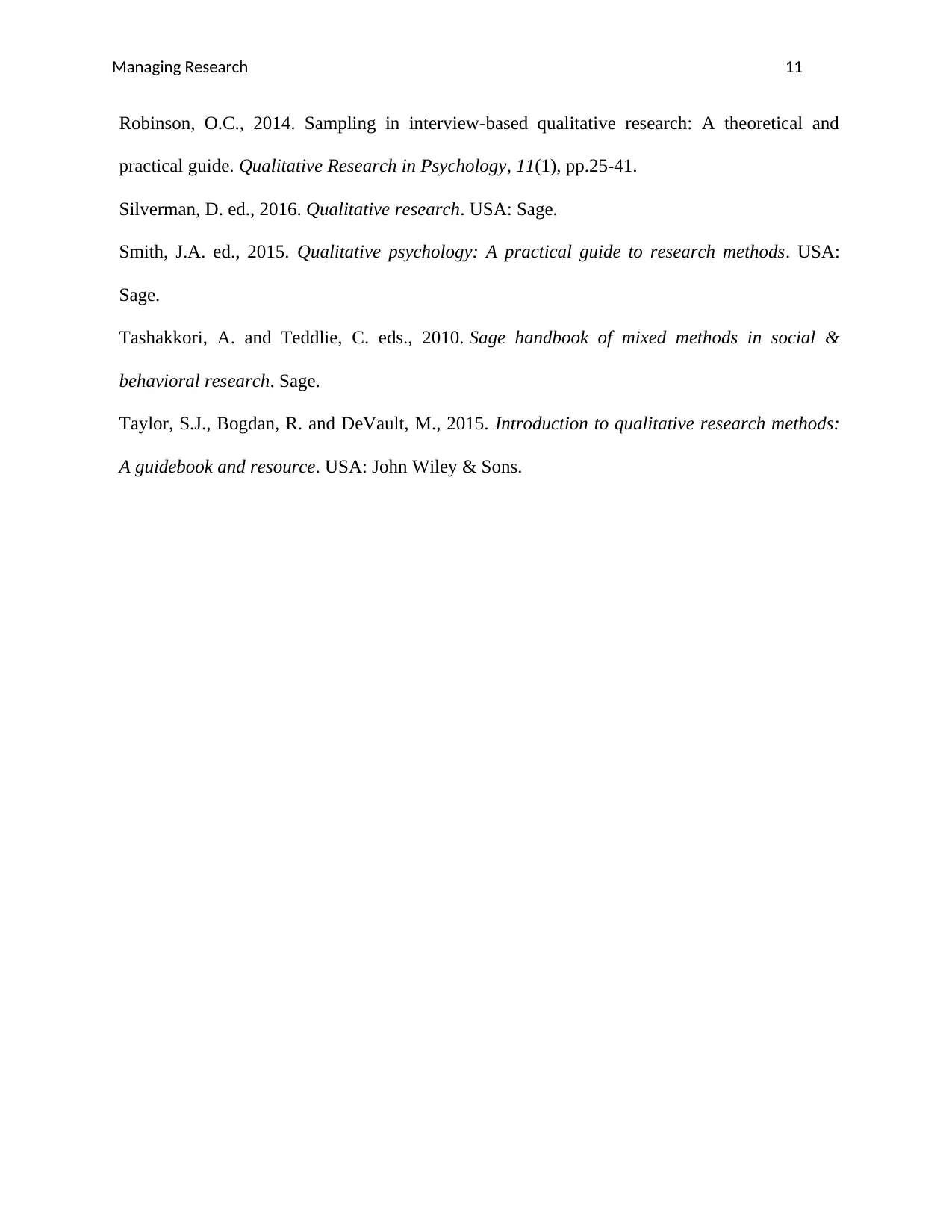
Managing Research 11
Robinson, O.C., 2014. Sampling in interview-based qualitative research: A theoretical and
practical guide. Qualitative Research in Psychology, 11(1), pp.25-41.
Silverman, D. ed., 2016. Qualitative research. USA: Sage.
Smith, J.A. ed., 2015. Qualitative psychology: A practical guide to research methods. USA:
Sage.
Tashakkori, A. and Teddlie, C. eds., 2010. Sage handbook of mixed methods in social &
behavioral research. Sage.
Taylor, S.J., Bogdan, R. and DeVault, M., 2015. Introduction to qualitative research methods:
A guidebook and resource. USA: John Wiley & Sons.
Robinson, O.C., 2014. Sampling in interview-based qualitative research: A theoretical and
practical guide. Qualitative Research in Psychology, 11(1), pp.25-41.
Silverman, D. ed., 2016. Qualitative research. USA: Sage.
Smith, J.A. ed., 2015. Qualitative psychology: A practical guide to research methods. USA:
Sage.
Tashakkori, A. and Teddlie, C. eds., 2010. Sage handbook of mixed methods in social &
behavioral research. Sage.
Taylor, S.J., Bogdan, R. and DeVault, M., 2015. Introduction to qualitative research methods:
A guidebook and resource. USA: John Wiley & Sons.
1 out of 11
Related Documents
Your All-in-One AI-Powered Toolkit for Academic Success.
+13062052269
info@desklib.com
Available 24*7 on WhatsApp / Email
![[object Object]](/_next/static/media/star-bottom.7253800d.svg)
Unlock your academic potential
Copyright © 2020–2025 A2Z Services. All Rights Reserved. Developed and managed by ZUCOL.





